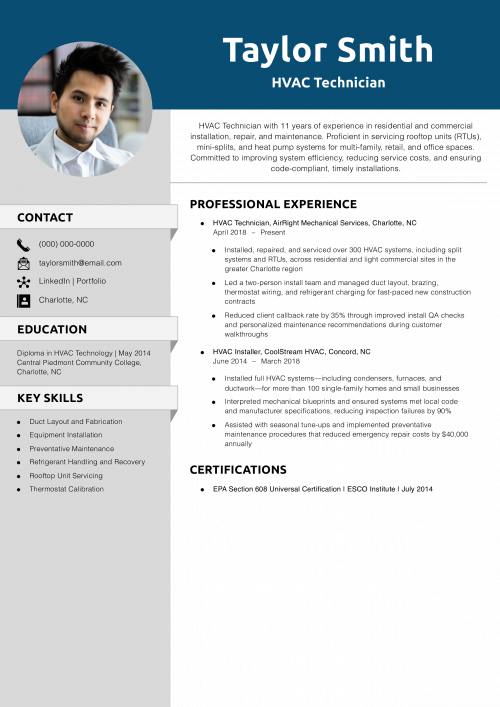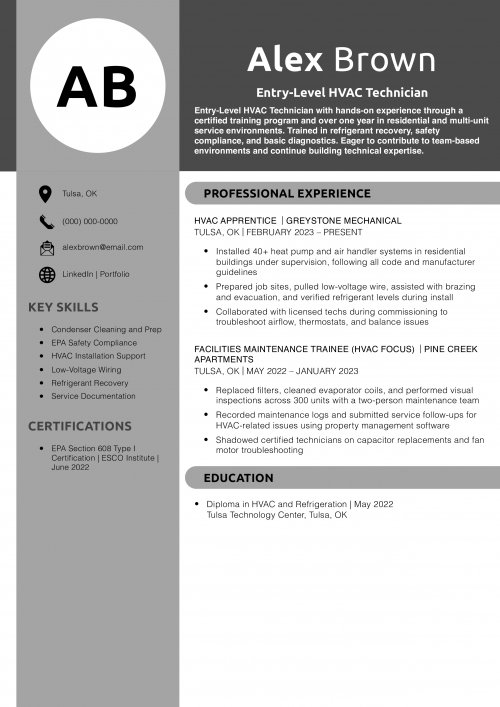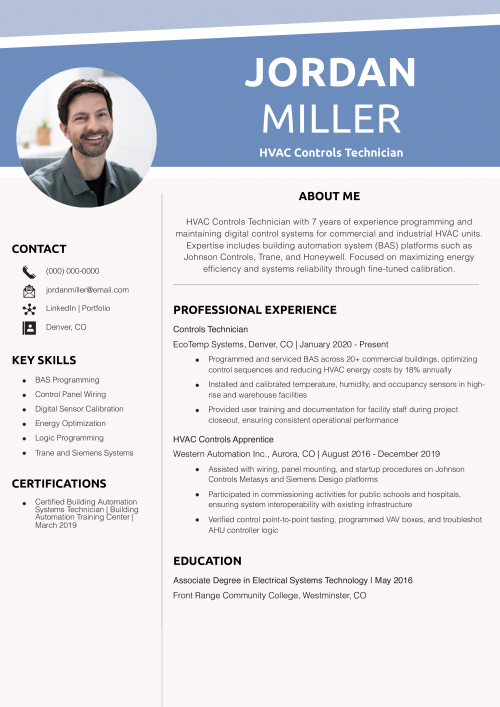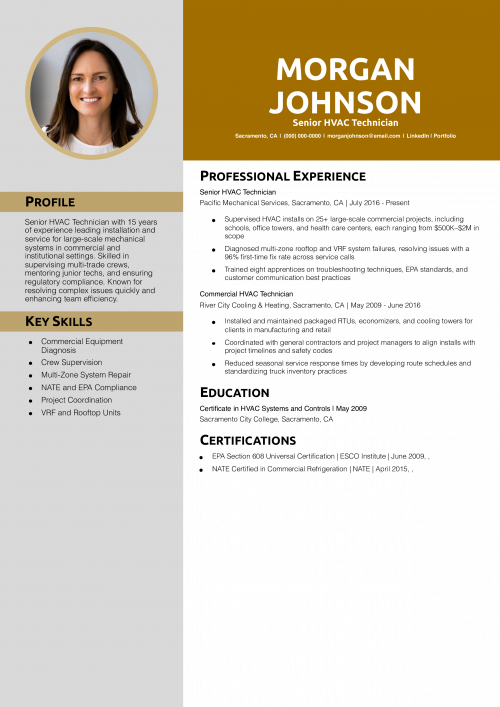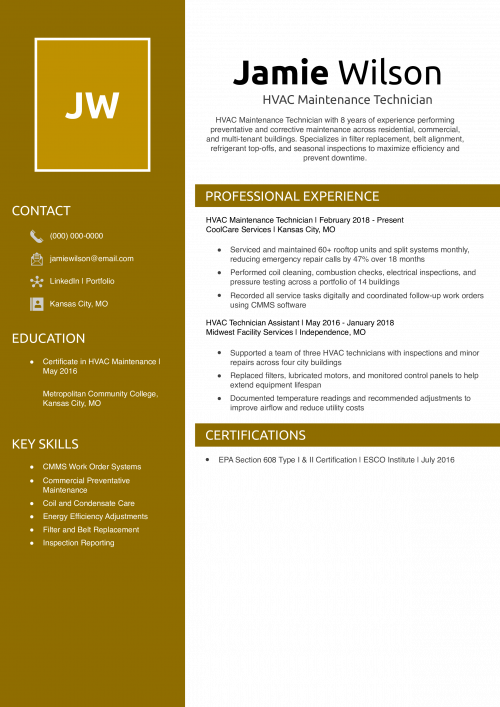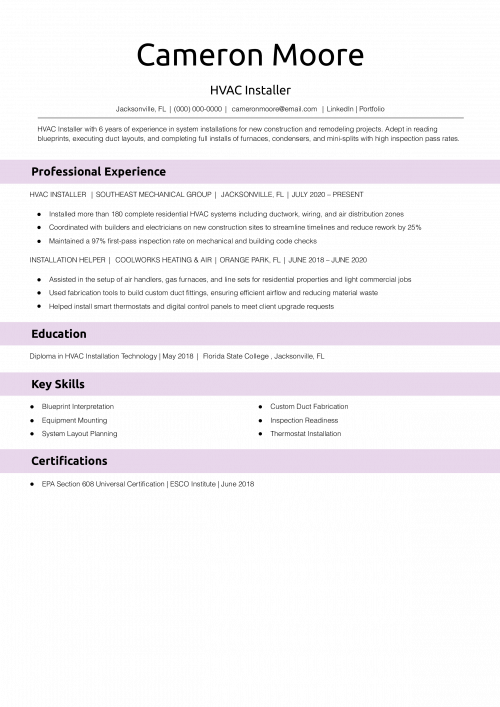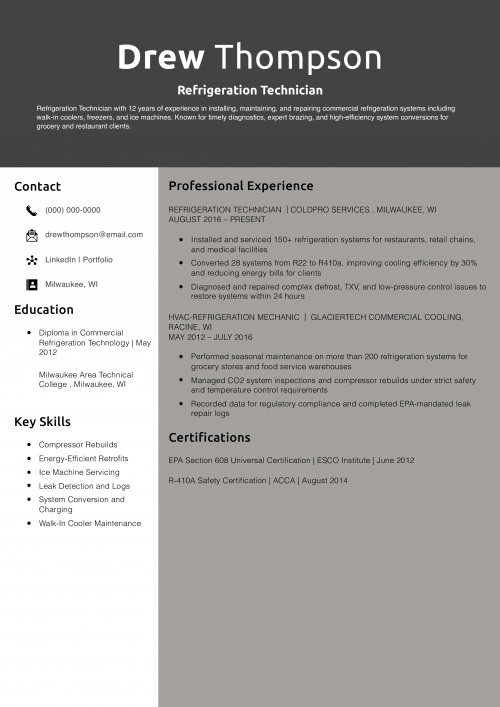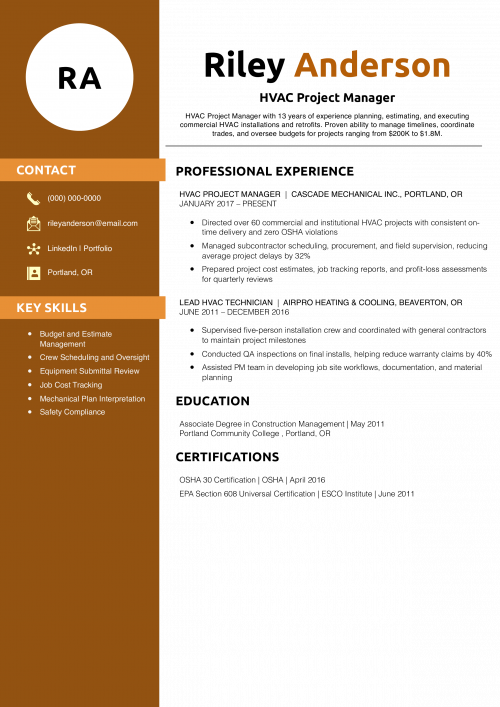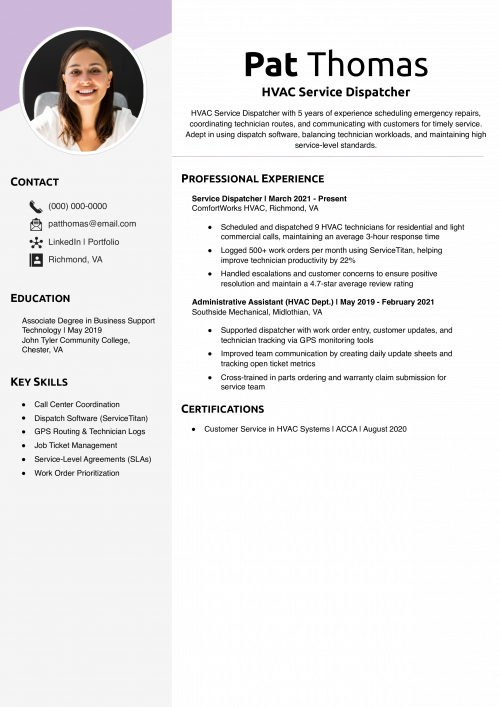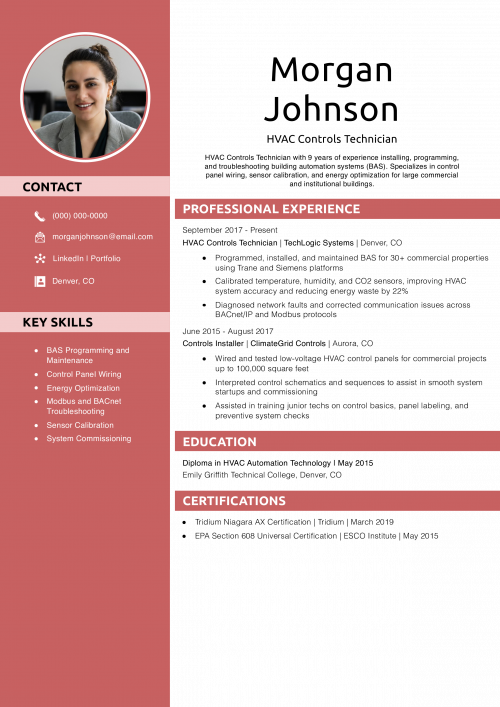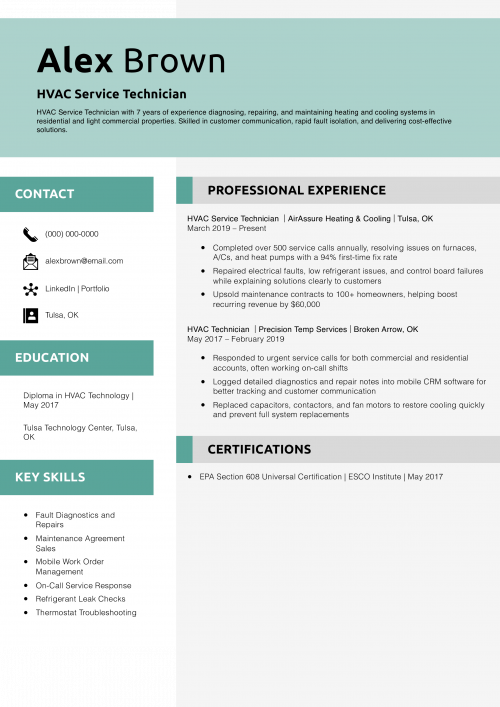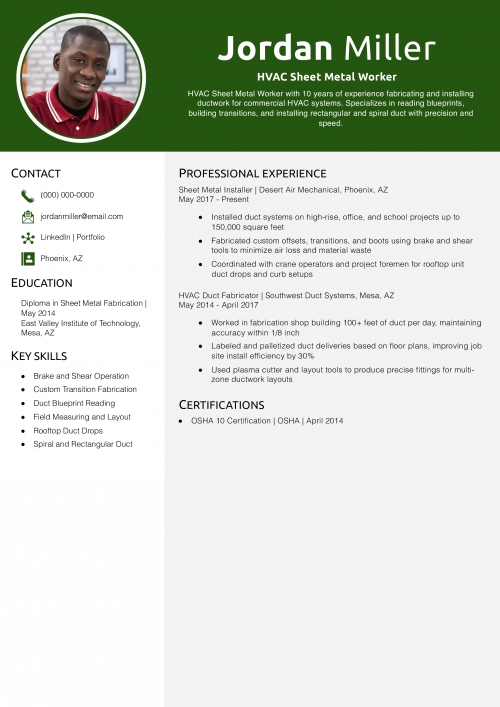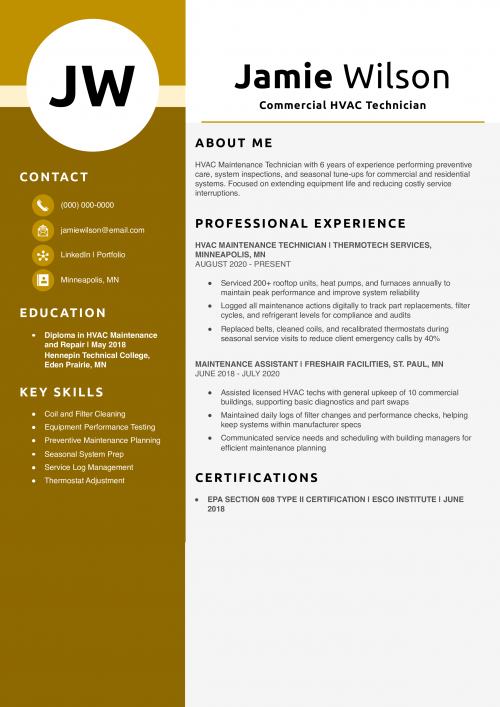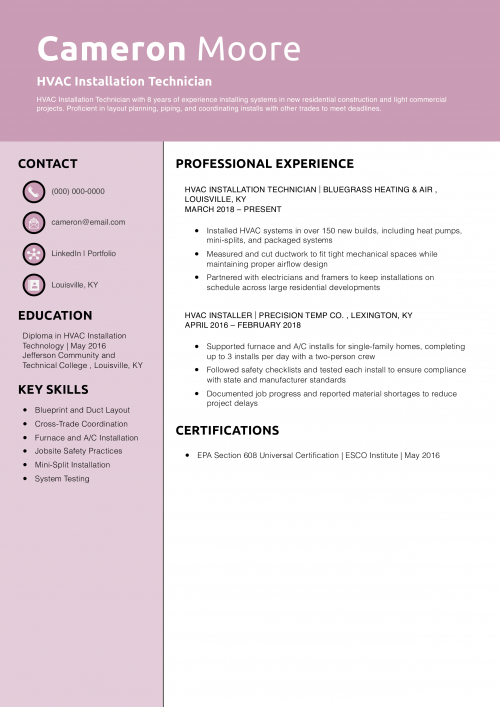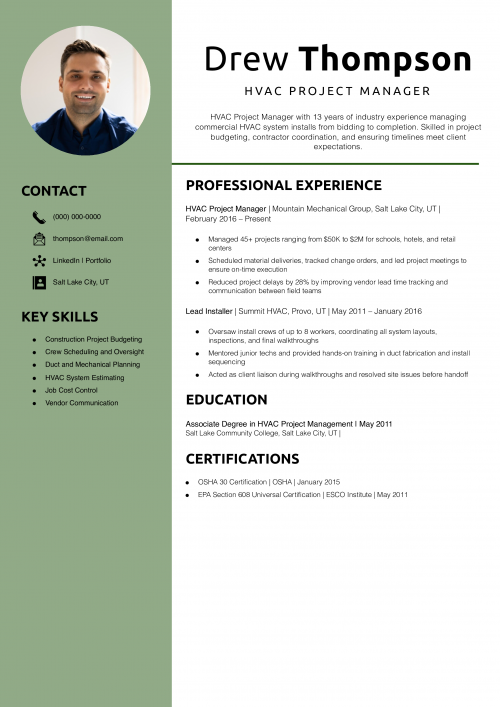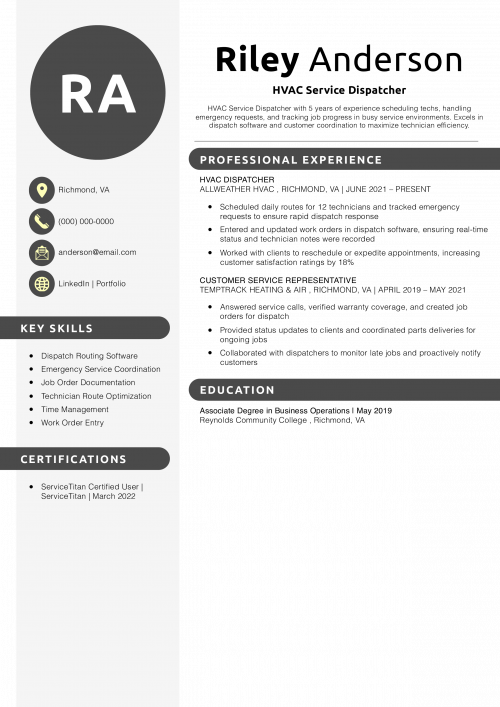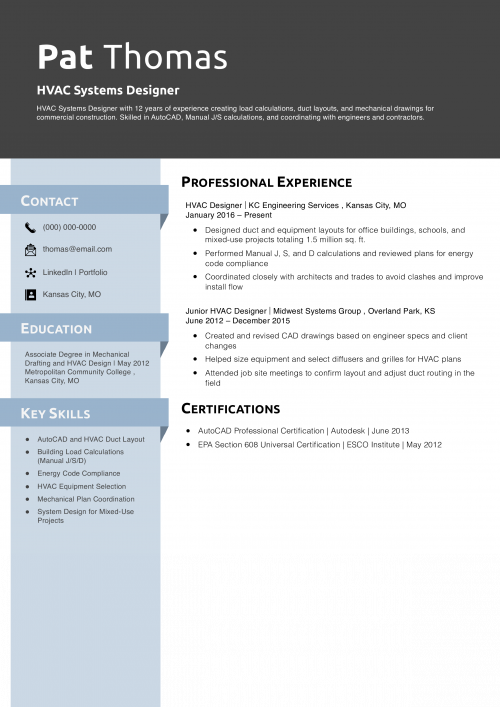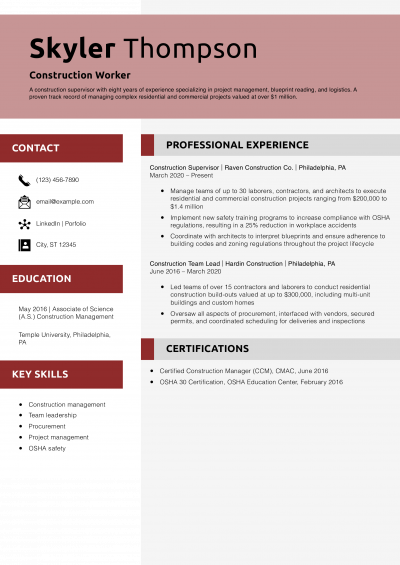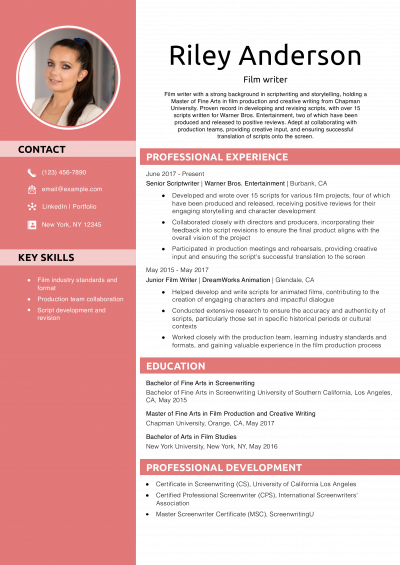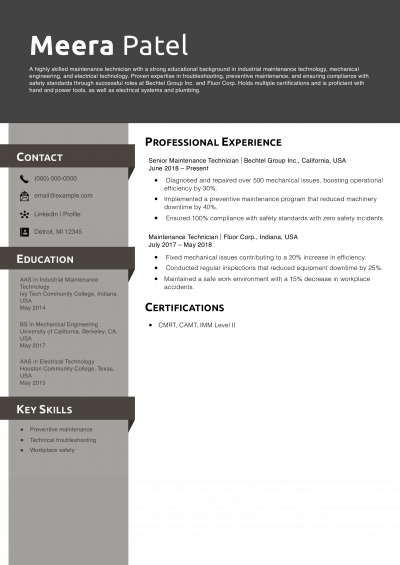With a rise in construction projects and a growing need for efficient energy solutions, demand for skilled HVAC technicians has increased over the past decade. That said, you still need an impactful resume to grab the attention of hiring managers in today’s competitive job market. In our guide, we’ll provide expert tips and insights to help you craft a powerful marketing document that captures your professional experience and accomplishments.
Whether you’re installing new residential systems, maintaining large commercial units, or troubleshooting complex ductwork and refrigeration issues, your HVAC resume should reflect both your technical skill set and reliability. HVAC professionals are trusted with the comfort and safety of clients across homes, schools, hospitals, and businesses—your resume needs to show that you not only know the work, but that you do it well and on time.
Key takeaways:
- Showcase your HVAC background: Highlight your areas of expertise as an HVAC professional, such as your experience installing and maintaining residential, commercial, or industrial systems.
- Quantify your achievements: Feature eye-catching numbers and metrics to establish a sense of scope for your accomplishments. For example, you might mention how your preventative maintenance efforts reduced downtime and repair costs.
- Optimize for the ATS: Incorporate HVAC-related skills from the job description to achieve compliance with applicant tracking systems (ATS), such as energy efficiency, building codes, and HVAC controls.
Most Popular HVAC Technician Resumes
HVAC Technician Resume Example
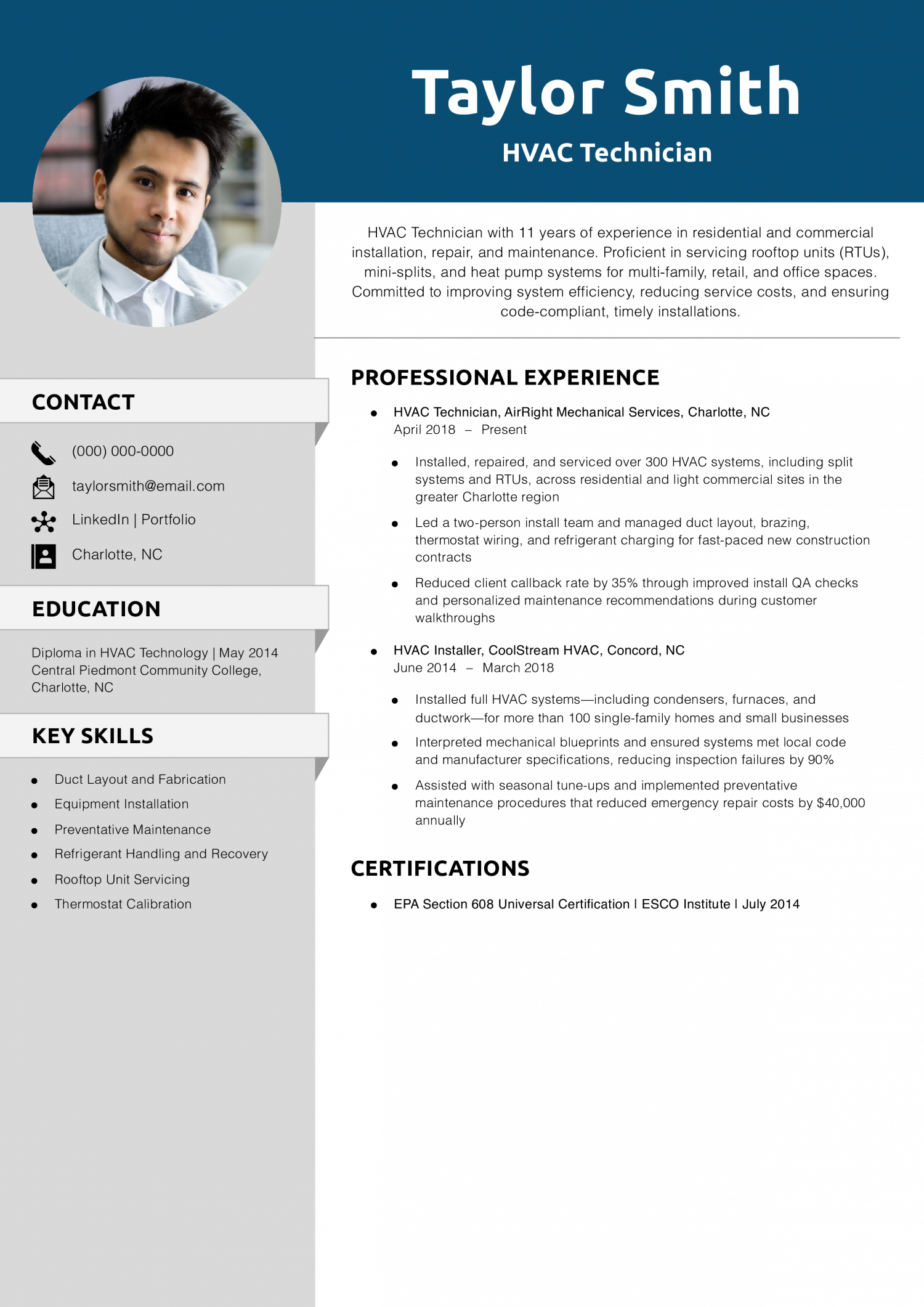
Why This Resume Is a Great Example
Taylor Smith’s resume highlights 11 years of consistent HVAC experience with impact-focused bullet points. Each entry clearly explains responsibilities and outcomes, using numbers to illustrate efficiency gains, cost reductions, and scope of work. This kind of detail helps recruiters visualize value. Learn how to highlight your background like Taylor with how to write a resume summary.
Entry-Level HVAC Technician Resume Example
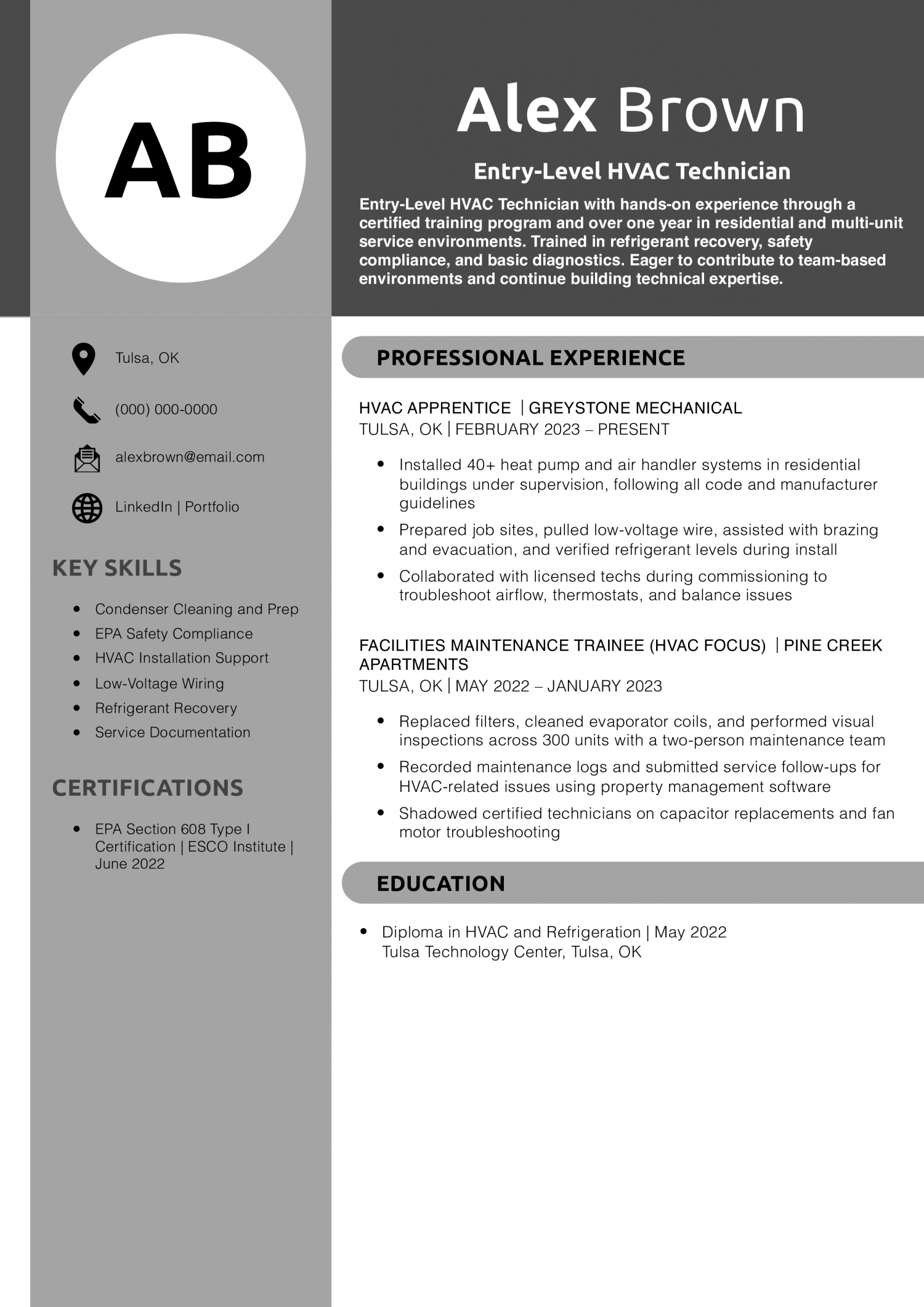
Why This Resume Is a Great Example
Alex Brown’s resume shows how new technicians can emphasize training and hands-on experience without overstating responsibilities. With clear structure and aligned dates, the resume provides a strong snapshot of Alex’s readiness for entry-level roles. Learn more at how to write your first job resume.
HVAC Controls Technician Resume Example

Why This Resume Is a Great Example
Jordan Miller’s resume focuses on systems control work with specific tools and measurable energy savings. This level of detail helps the resume stand out among candidates with similar experience. Learn how to craft precise achievements at resume action words.
Senior HVAC Technician Resume Example
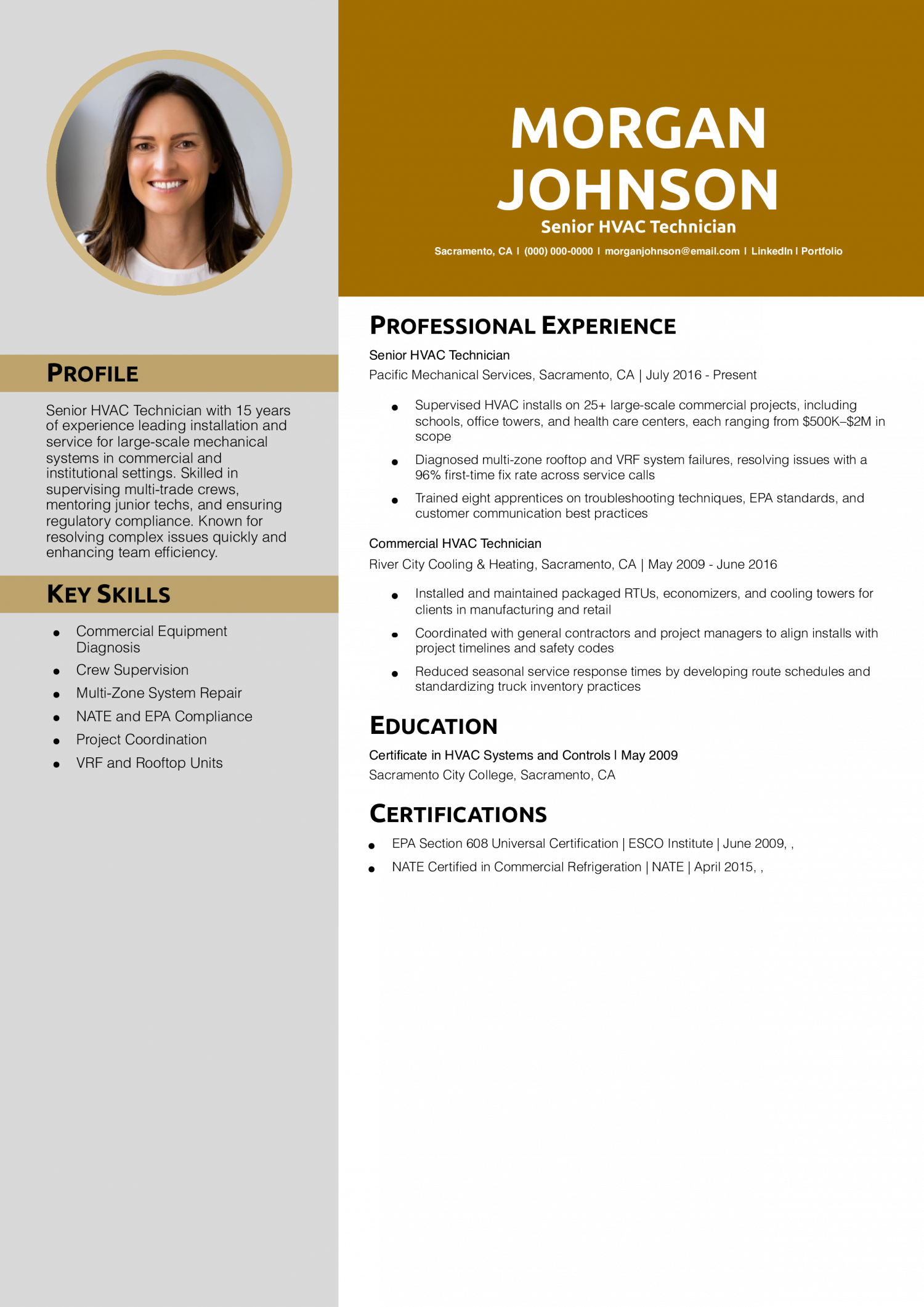
Why This Resume Is a Great Example
Morgan Johnson’s resume builds on senior-level leadership and advanced technical experience. The bullet points emphasize large-scale project impact and mentorship, making it clear Morgan can lead from both the job site and the service truck. For senior role strategies, visit resume job description.
HVAC Service Technician Resume Example

Why This Resume Is a Great Example
Casey Davis’s resume emphasizes practical service work and the ability to deliver consistent results in the field. The metrics used—like customer satisfaction and service volume—help the experience feel tangible and impressive. Explore more service-focused resume ideas at work experience on a resume.
HVAC Maintenance Technician Resume Example
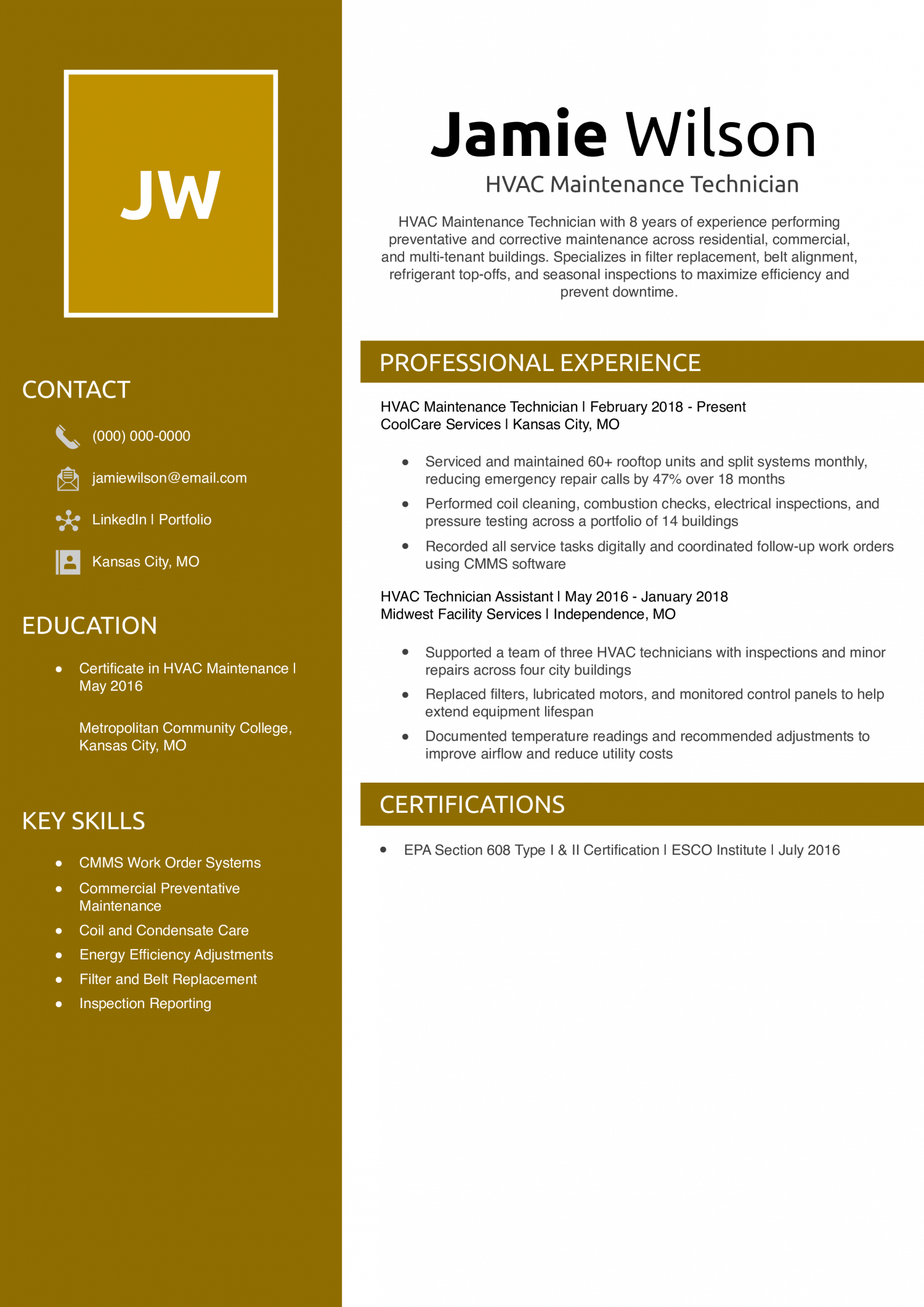
Why This Resume Is a Great Example
Jamie Wilson’s resume clearly outlines the scope and impact of ongoing maintenance work. It demonstrates the ability to manage large property portfolios and implement routine procedures that drive cost savings. For tips on job-specific formatting, check out best resume formats.
HVAC Installer Resume Example
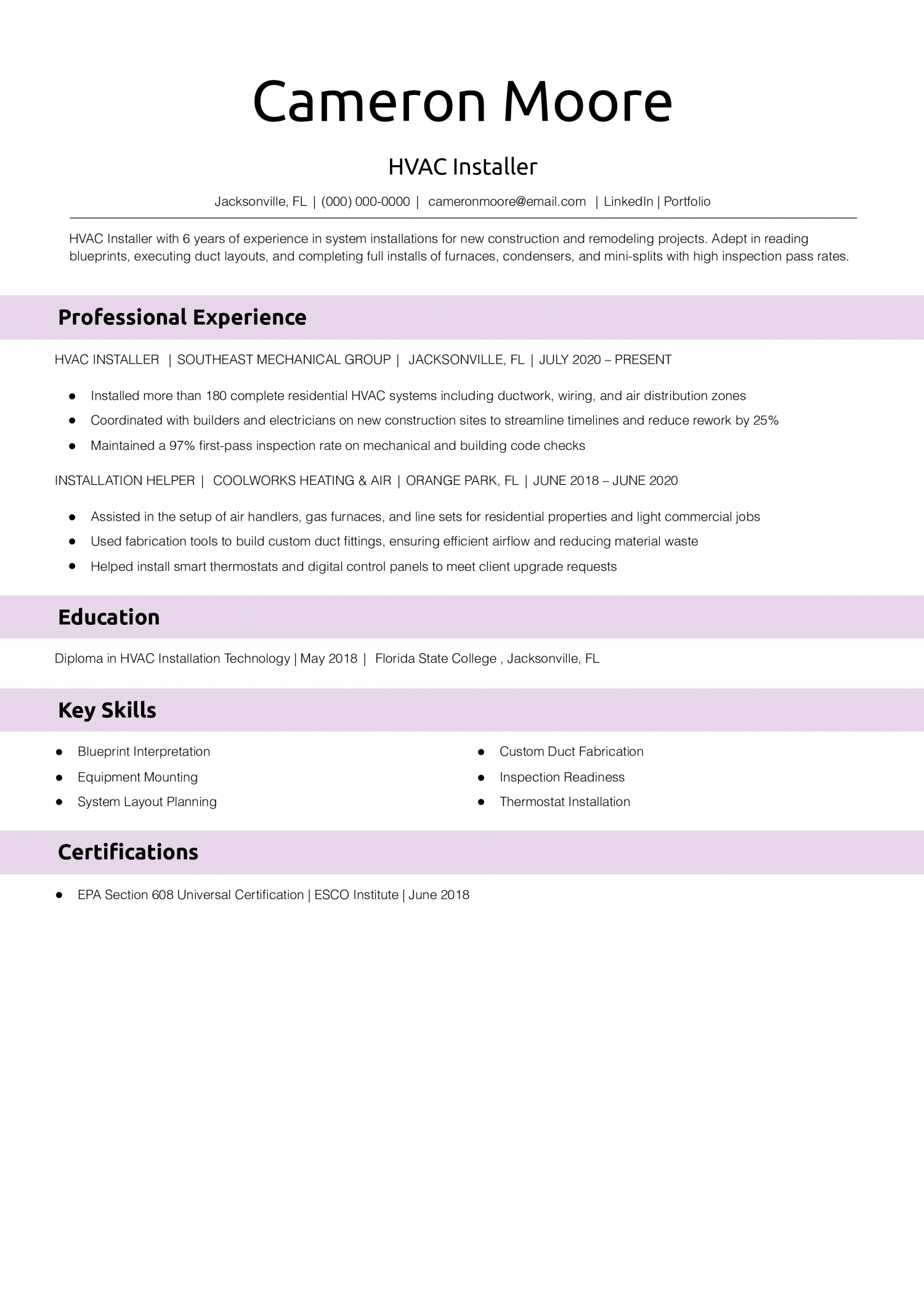
Why This Resume Is a Great Example
Cameron Moore’s resume captures both independent and team-based install experience, supported by performance metrics like inspection pass rates. It’s focused, relevant, and easy to scan. Learn how to align your resume with your strengths at how to list skills on a resume.
Refrigeration Technician Resume Example
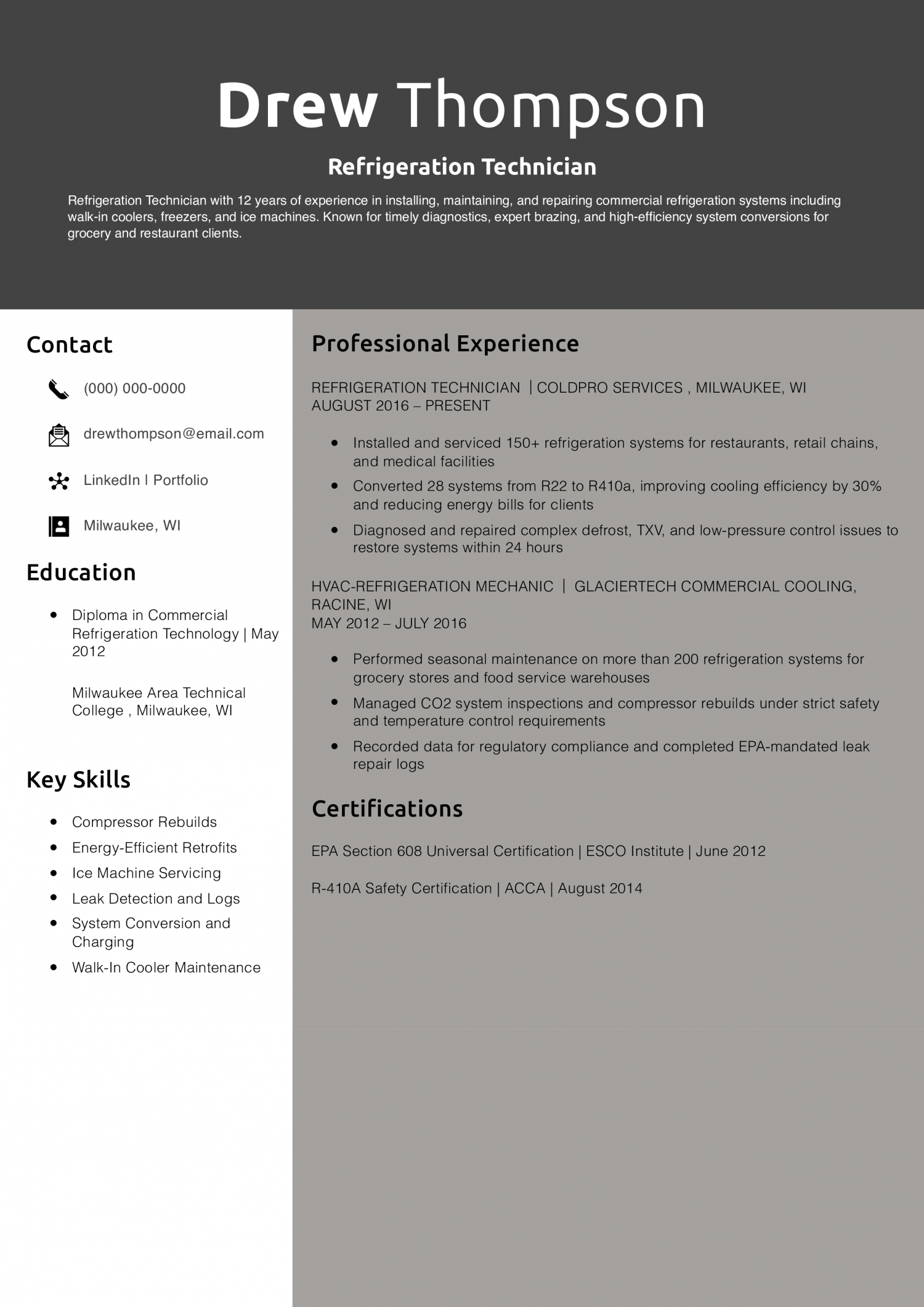
Why This Resume Is a Great Example
Drew Thompson’s resume demonstrates depth in a specialized HVAC niche, pairing years of experience with targeted outcomes. It’s ideal for employers needing refrigeration-specific skills. Discover more about building niche resumes at career advice: job titles for resume.
HVAC Project Manager Resume Example
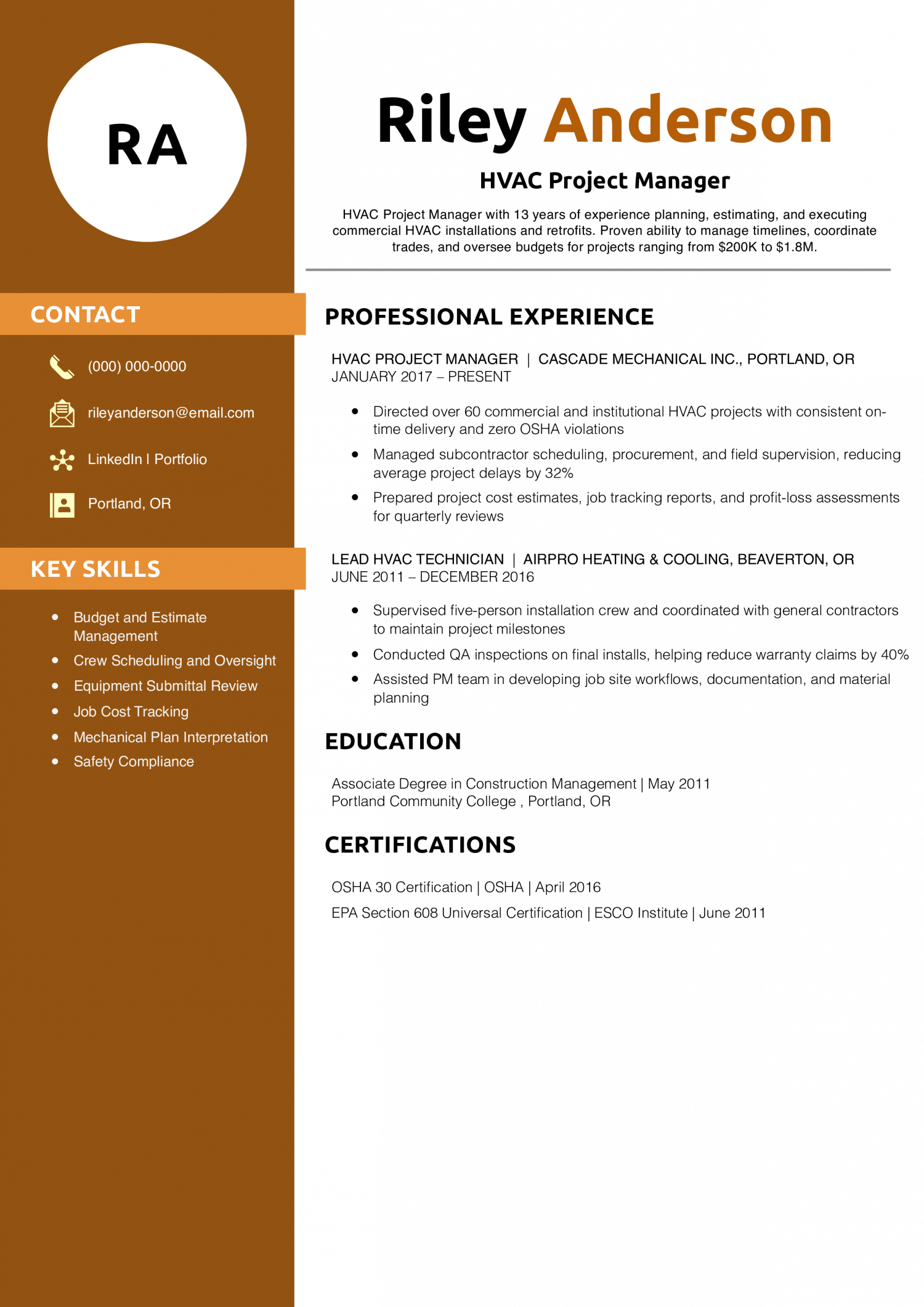
Why This Resume Is a Great Example
Riley Anderson’s resume connects field knowledge with leadership and business skills. By showing ownership over budgets, safety, and schedules, it signals career growth and accountability. Learn to showcase leadership impact like Riley at leadership skills for resume.
HVAC Service Dispatcher Resume Example
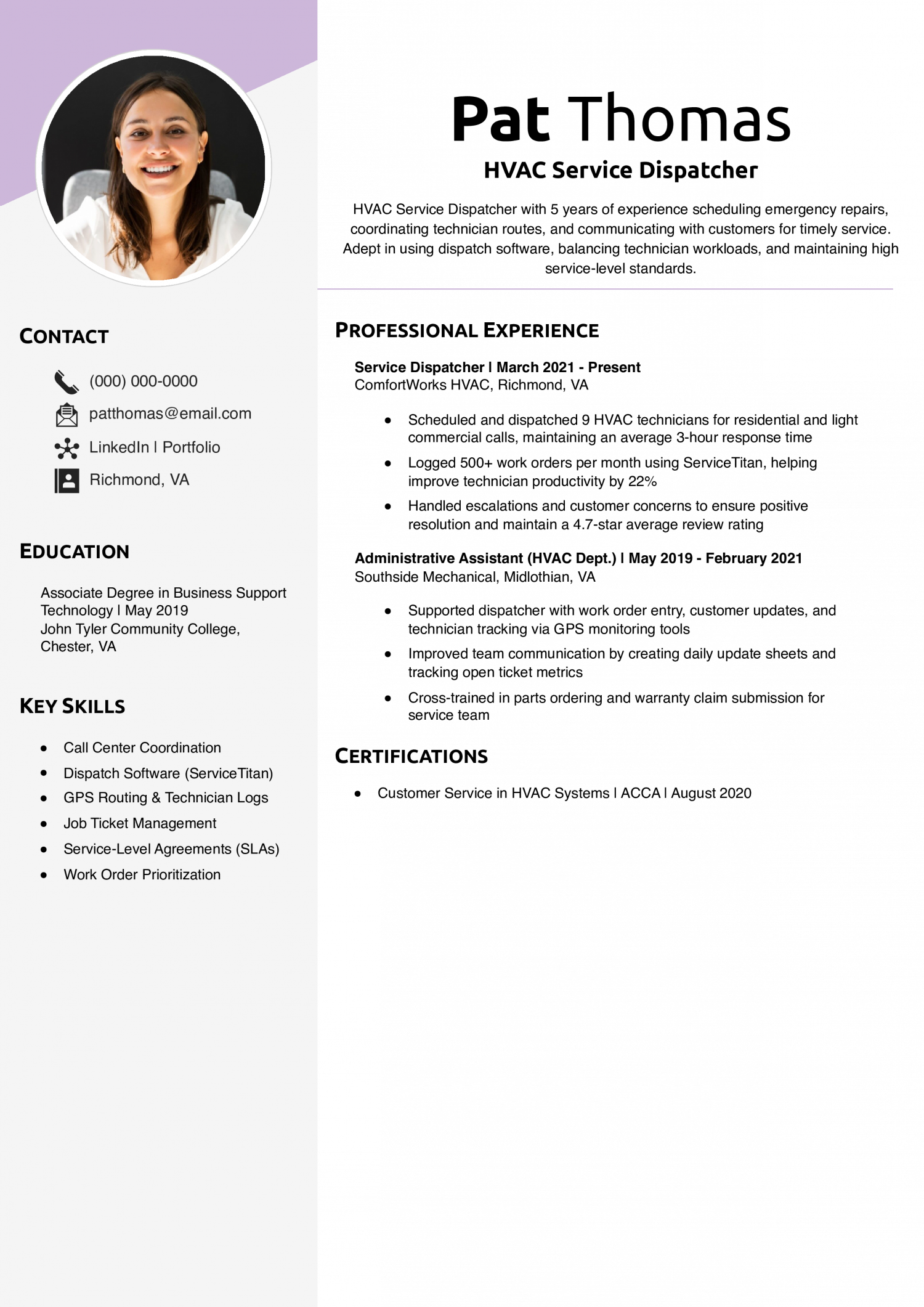
Why This Resume Is a Great Example
Pat Thomas’s resume shows how dispatchers support field operations by maintaining communication and organization. Pat’s contributions are measurable, which helps employers see value beyond logistics. Learn how to write like this at how to build a professional resume.
HVAC Controls Technician Resume Example
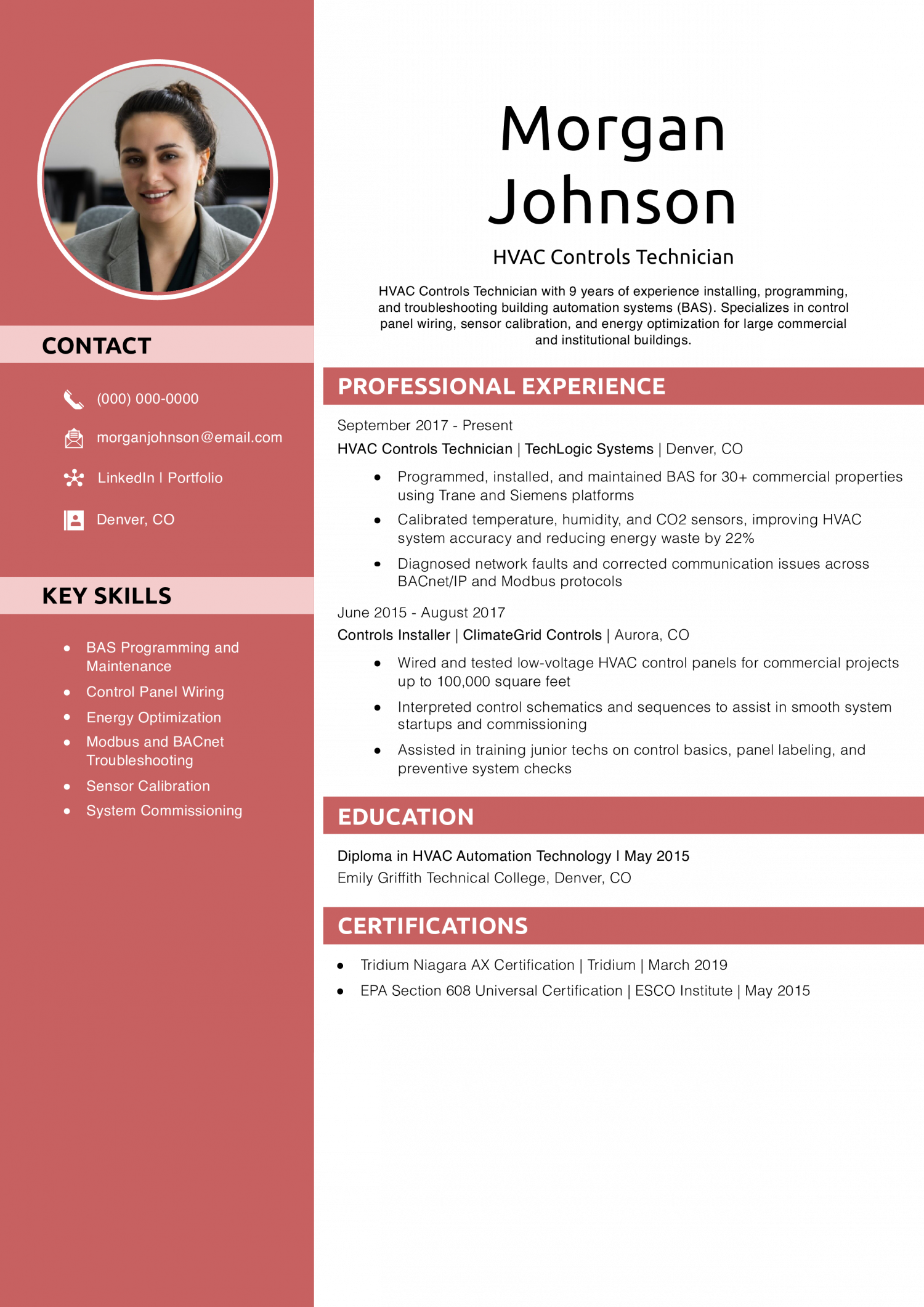
Why This Resume Is a Great Example
Morgan Johnson’s resume zeroes in on technical expertise in controls and automation. The bullet points are packed with measurable outcomes and tools that hiring managers look for in specialized roles. For more on structuring a standout resume, check out how to make a resume.
HVAC Apprentice Resume Example

Why This Resume Is a Great Example
Taylor Smith’s resume is tailored for early-career HVAC professionals. It highlights relevant experience from apprenticeship and school-based internships, which is key when full-time history is limited. Learn how to write a strong early resume at how to write your first job resume.
HVAC Service Technician Resume Example
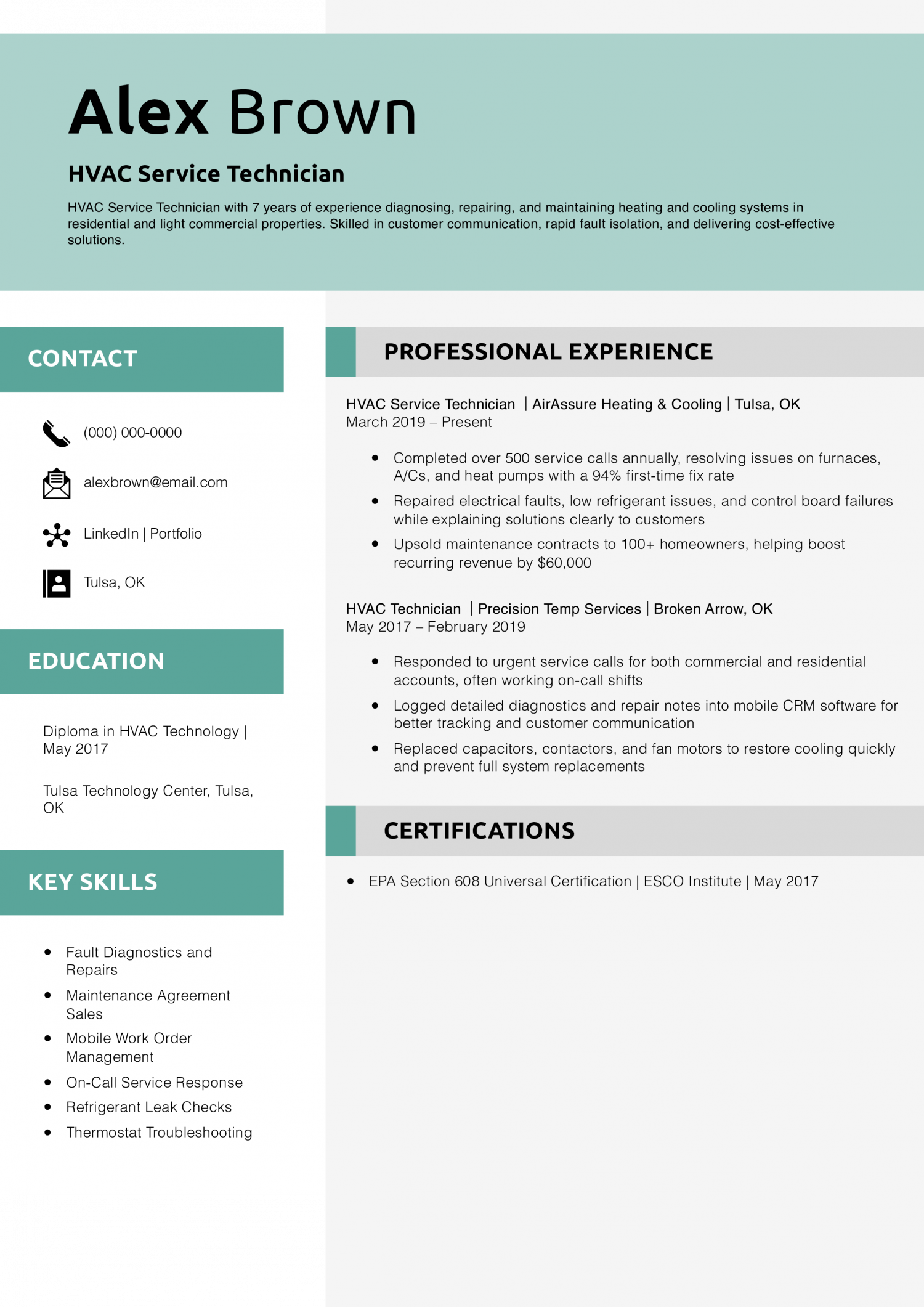
Why This Resume Is a Great Example
Alex Brown’s resume is grounded in metrics that matter—first-time fix rate, upsell impact, and service call volume. It paints a clear picture of technical ability and customer interaction. Learn how to include numbers that stand out at resume action words.
HVAC Sheet Metal Worker Resume Example
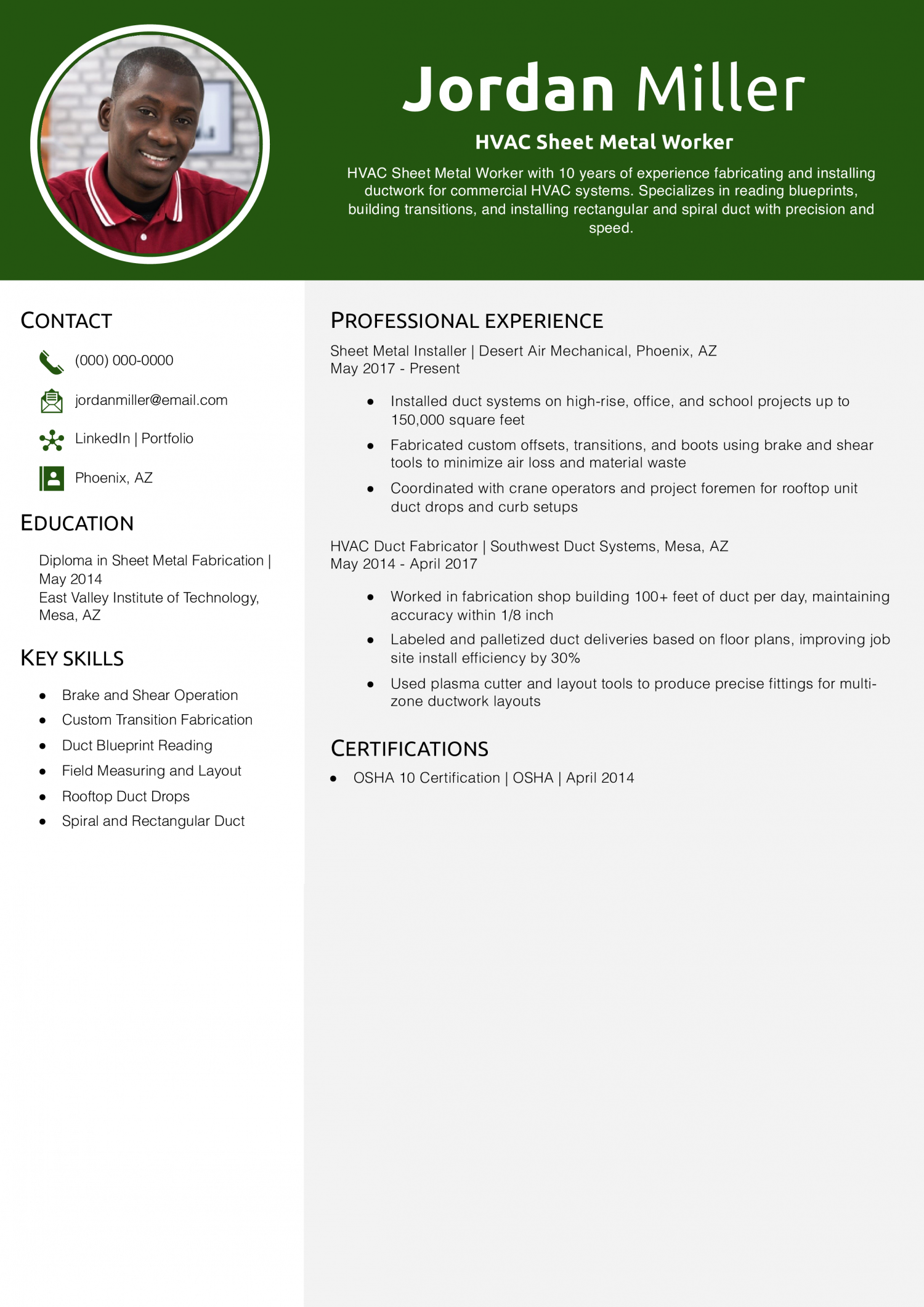
Why This Resume Is a Great Example
Jordan Miller’s resume shows craftsmanship and productivity, using numbers that reflect experience in commercial HVAC duct installation. It also signals safety and blueprint fluency. Want more on job-specific terms? Check out resume keywords.
Commercial HVAC Technician Resume Example

Why This Resume Is a Great Example
Casey Davis’s resume is built for complex commercial service roles. From BAS systems to LEED support, each bullet shows how Casey adds value in high-demand environments. For more on showcasing technical range, visit core competencies resume.
HVAC Maintenance Technician Resume Example
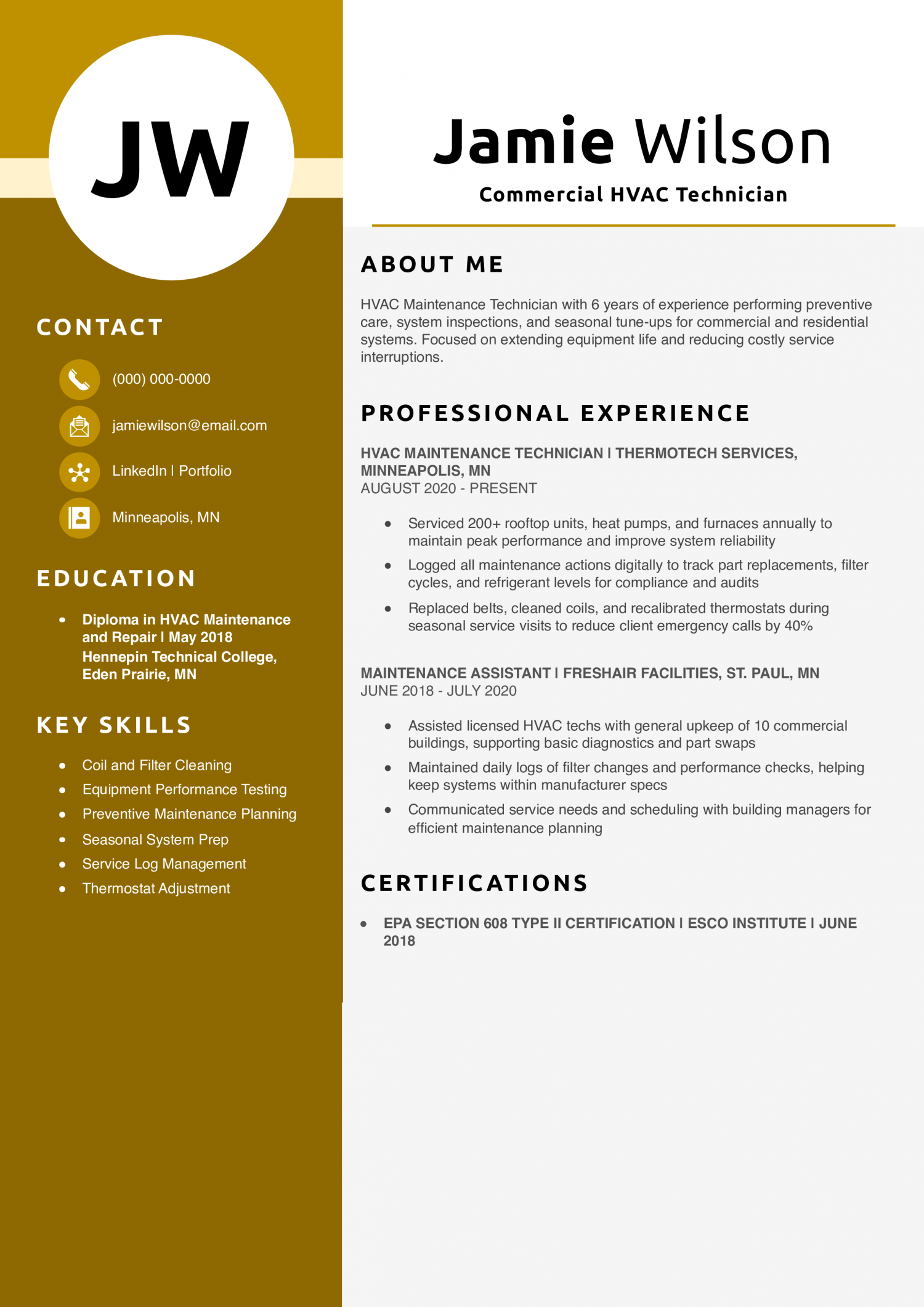
Why This Resume Is a Great Example
Jamie Wilson’s resume is focused and practical. It clearly shows the technician’s maintenance-driven role and uses results—like reduced emergency calls—to show value. For help building similar clarity into your own resume, read what to put on a resume.
HVAC Installation Technician Resume Example

Why This Resume Is a Great Example
Cameron Moore’s resume highlights speed, volume, and cross-functional collaboration—all essential traits in fast-paced install roles. The structure makes it easy to see where and how Cameron contributed. For more on organizing experience like this, see resume job description.
HVAC Project Manager Resume Example

Why This Resume Is a Great Example
Drew Thompson’s resume is built to impress hiring managers looking for leadership and results. Each bullet connects project size with outcomes like cost savings and fewer delays. Learn how to lead with impact like Drew at resume personal statement examples.
HVAC Service Dispatcher Resume Example
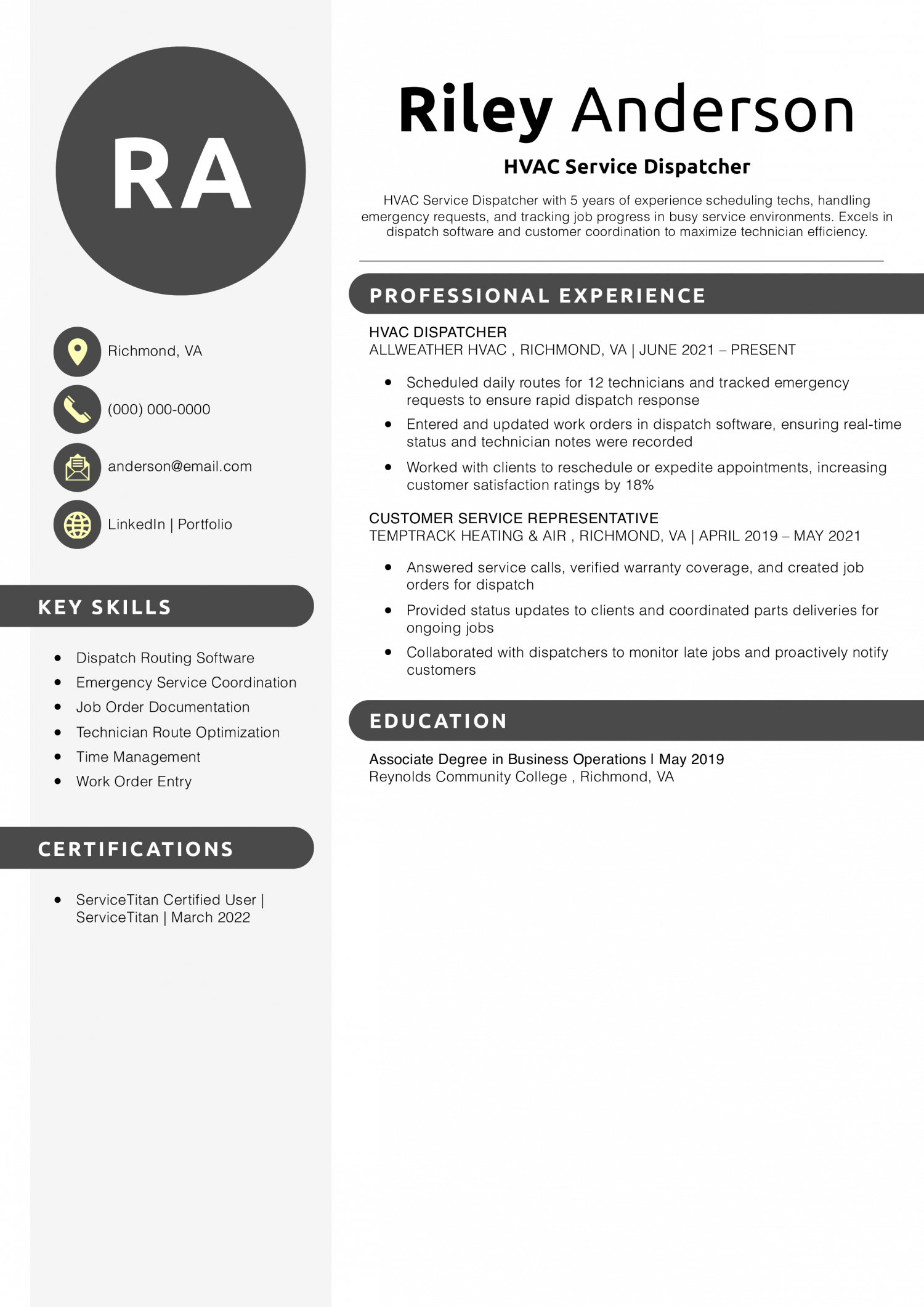
Why This Resume Is a Great Example
Riley Anderson’s resume shows the connection between field operations and customer experience. With clear data on call volume and software tools, it reflects both administrative and logistical strengths. See how to describe operational roles with impact at work experience on a resume.
HVAC Systems Designer Resume Example
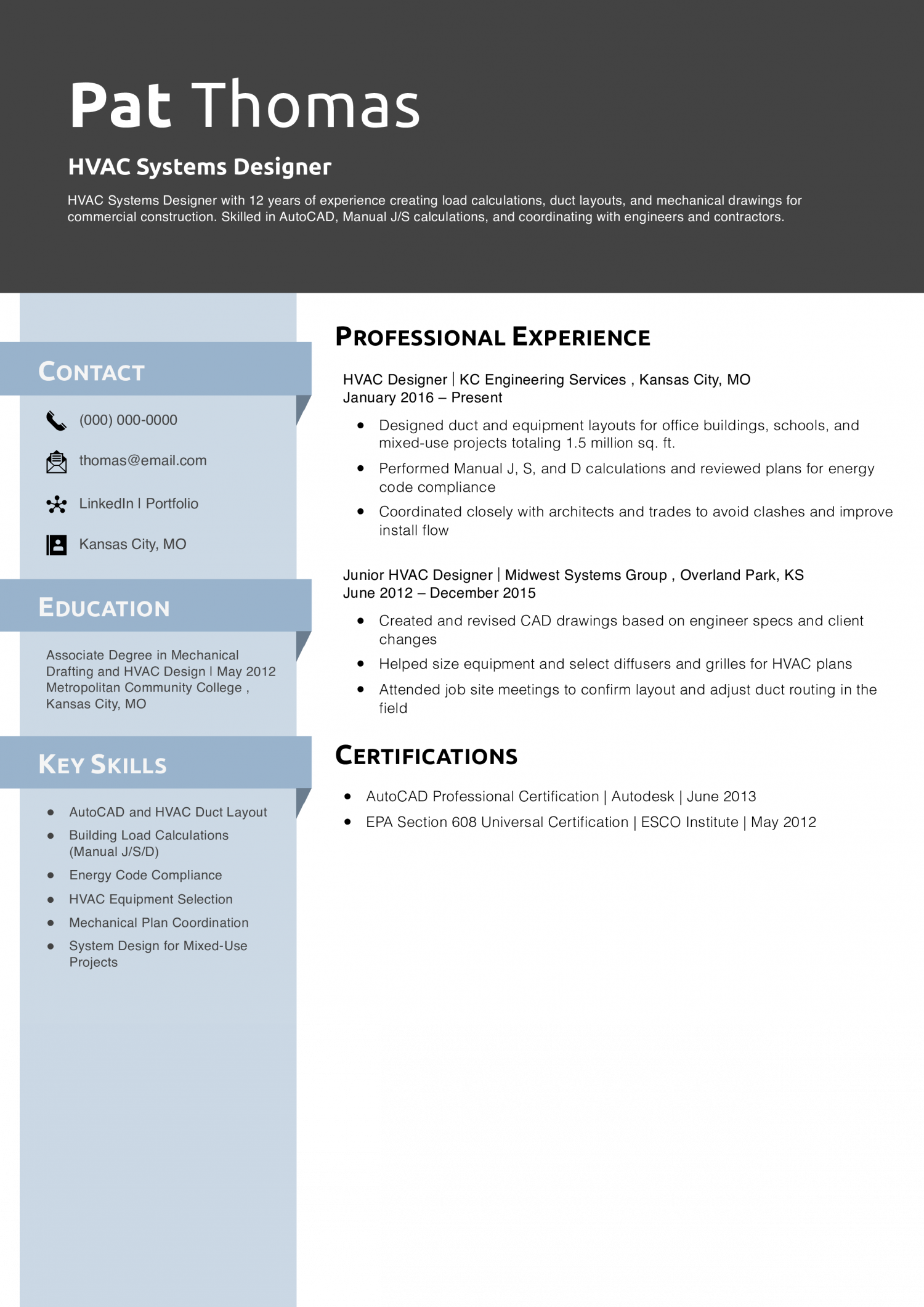
HVAC Technician Text-Only Resume Examples and Templates
How To Write an HVAC Resume Example
Major commercial HVAC installations require strategic planning and a thorough assessment of the building site. The same is true for your resume, as it’s essential to have a structure in place that allows the hiring manager to easily navigate your work history, qualifications, and achievements. Opt for a clean, single-column layout that prioritizes your content over flashy visual elements. Be sure that your resume template includes the following sections:
Your HVAC resume should include these sections:
- Contact information
- Profile
- Key skills
- Professional experience
- Education and certifications
1. Share your contact information
List your full name, phone number, email address, city, and state. Review the accuracy of your information to ensure the hiring manager can easily reach out to schedule an interview.
Example:
YOUR NAME
[email protected] | (123) 456-7890 | City, ST | LinkedIn
2. Write a compelling profile summarizing your HVAC qualifications
To make a strong first impression on the hiring manager, lead with an engaging introduction that provides an overview of your career within the HVAC field. Start with a sentence that lists your title, years of experience, and three to four specializations that align with the organization’s needs. This immediately shows potential employers that you have the industry knowledge and technical capabilities to succeed.
Use the remainder of your paragraph to emphasize the most impressive aspects of your background as an HVAC technician. For example, if you have experience working on multi-million dollar industrial installations, be sure to highlight this information directly in your profile.
Senior-level profile example:
HVAC technician with 12 years of experience specializing in commercial systems, ductwork retrofits, and high-efficiency installations. EPA-certified and experienced with Lennox, Trane, and Carrier equipment. Known for minimizing system downtime and improving energy efficiency in retail and warehouse facilities.
Entry-level profile example:
Entry-level HVAC technician with hands-on training in system maintenance, repairs, and safety compliance. Strong mechanical aptitude and certified in EPA Section 608. Seeking to join a service team that values reliable, safety-conscious work.
3. Add a results-driven professional experience section
Your work history section needs to capture your story as an industry professional. Rather than simply documenting your daily duties, focus on illustrating what you’ve achieved over the course of your career. For example, what was the size of your largest commercial installation? How did your preventative maintenance efforts positively impact the company’s bottom line? Did you collaborate with other trades to execute large construction projects? These kinds of insights are a great way to show potential employers that you can deliver real value to their organizations.
Senior-level professional experience example:
HVAC Technician
CoolZone Mechanical | Houston, TX | March 2015 – to present
- Installed and maintained commercial rooftop units for 50+ retail clients, reducing emergency callouts by 40%
- Diagnosed and repaired industrial refrigeration systems, improving operational uptime by 25% over 12 months
- Trained two apprentices in safe installation practices and EPA compliance procedures
Entry-level professional experience example:
HVAC Apprentice
Smith & Sons Heating | Tampa, FL | July 2022 – to present
- Assisted senior techs on 30+ service calls weekly, learning hands-on skills in diagnostics and preventative maintenance
- Maintained worksite cleanliness, logged repair data, and prepped tools and parts for installations
- Supported coil cleanings, filter changes, and refrigerant level checks in residential homes
Resume writer’s tip: Quantify your experience
Featuring hard numbers, metrics, and monetary figures can greatly enhance your bullet points, allowing the hiring manager to gain a better understanding of your accomplishments. For example, say you performed residential HVAC installations. While the monetary value of an individual project won’t be as high as a commercial job, they add up. Stating that you managed over 40 residential HVAC installations ranging from $4,000 to $20,000 shows employers that you can generate consistent results.
Do
- “Installed HVAC systems for 35 new-construction homes in under six months, staying under budget and ahead of schedule”
Don’t
- “Installed HVAC systems in new construction projects”
Resume writer’s tip: Tailor your resume for each application
Always take the extra step to customize your resume for individual job applications. You don’t need to rewrite your document from the ground up, but rather alter the content to show employers you have the knowledge and expertise to excel in the position. For instance, if a company is looking for a technician with experience in commercial HVAC, highlight examples of you performing installations for schools, hospitals, and other large buildings.
What if you don’t have experience?
If you’re entering the field for the first time, you’ll need to prioritize training, certifications, and skills to compensate for a lack of work history. Internships are highly recommended as a way to gain more hands-on experience. You can also highlight the projects you worked on while completing your HVAC program to show hiring managers you’re prepared for an entry-level role.
4. Include relevant education and certifications
HVAC professionals don’t always need a degree, but your technical training and certifications are vital. List your trade school, relevant coursework, and dates completed. Always include EPA certification, and add state licenses or manufacturer-specific training (e.g., NATE, OSHA 10).
Education
Diploma in HVAC Technology | May 2022
Lincoln Technical Institute | Nashville, TN
Certifications
- EPA Section 608 Universal Certification | ESCO Institute | June 2022
- NATE Certified HVAC Technician | NATE | August 2023
- OSHA 10 Certification | U.S. Department of Labor | January 2023
5. List pertinent key skills
The last thing you want during the job search is to get automatic rejections from an AI screening tool. To get your resume through the ATS and into the hiring manager’s hands, you need a comprehensive list of your skill sets. Highlight keywords directly from the job posting, such as specific HVAC equipment, tools, and safety protocols. Below, you’ll find a collection of recommended skills to consider adding to your resume:
| Key skills | |
|---|---|
| Air conditioning repair | Blueprint reading |
| Commercial HVAC installation | Ductwork fabrication |
| Energy efficiency upgrades | Electrical repairs |
| HVAC controls | Industrial HVAC installation |
| OSHA safety | Preventative maintenance |
| Project management | Refrigerant recovery |
| Residential HVAC systems | System troubleshooting |
| Thermostat installation | Ventilation systems |
Resume writer’s tip: Use common action verbs
Open each bullet point with a powerful action verb to add an engaging and dynamic element into your writing. Using proactive language allows the hiring manager to better visualize your contributions. Conversely, passive language such as “helped,” “assisted,” or “responsible for,” places you in much more of a supporting role, diminishing your level of responsibility. Below, you’ll find a list of action verbs you can use to craft the professional experience section of your resume:
| Common action verbs for HVAC resumes | |
|---|---|
| Analyzed | Adjusted |
| Built | Calibrated |
| Delivered | Diagnosed |
| Drove | Fabricated |
| Identified | Installed |
| Implemented | Improved |
| Led | Maintained |
| Managed | Performed |
| Provided | Repaired |
| Supervised | Tested |
| Upgraded | |
How To Pick the Best HVAC Resume Template
Use a resume template that’s easy to scan and puts your qualifications front and center. Avoid overly stylized designs or colorful layouts—clean structure matters more. Make sure your certifications, experience, and skills are easy to find at a glance. Choose a layout where bullet points and job titles stand out clearly.
Frequently Asked Questions: HVAC Resume Examples and Advice
According to the Bureau of Labor Statistics, employment opportunities for HVAC technicians is projected to grow 9% from 2023 to 2033. Despite the growing demand within this industry, it's still essential to go the extra step and align your resume with the job description, especially for the most lucrative roles. For instance, say a company is looking for a candidate with a strong background in energy efficiency. Feature examples of how you lowered costs by performing upgrades or installing cutting-edge solutions such as solar technology.
Reverse chronological is the ideal format for HVAC technician resumes. This approach places your most recent experience first, allowing the hiring manager to quickly view your career progression and accomplishments. A combination approach should only be considered by entry-level job seekers who need to showcase training programs, internships, and skills to compensate for a limited work history.
Include a cover letter with your resume
Although most companies won’t require a cover letter for HVAC technician job applications, including one could provide a competitive advantage. The cover letter complements your resume, allowing you to mention specific details about the company’s reputation and culture. It also shows that you’re willing to go above and beyond what’s expected of you, something that hiring managers are sure to take notice of.
Check Out Related Examples
Resume Templates offers free, HR approved resume templates to help you create a professional resume in minutes. Choose from several template options and even pre-populate a resume from your profile.

